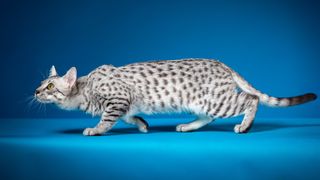
Killer squirrels, backyard fossil finds and a 124th birthday party for a giant crocodile are just some of the headlines we've seen in this week's science news. But unfortunately it hasn't all been fun and games.
The U.S. has reported its first severe case of bird flu after a patient was hospitalized in Louisiana. Meanwhile, California has declared a state of emergency as the virus continues to tear through the state's dairy herds. However, to date, no person-to-person spread of the virus has been reported in the U.S. and, according to the U.S. Centers for Disease Control and Prevention (CDC), the risk to the general public is still low.
Christian amulet could rewrite history
1,800-year-old silver amulet could rewrite history of Christianity in the early Roman Empire

A small, silver amulet found alongside a skeleton in a cemetery in Germany may be the oldest evidence of Christianity north of the Alps, new research suggests.
The discovery was made by digitally unrolling a tiny silver scroll, which would have likely been worn on a cord around the neck. The inscription inside speaks of the owner's devout faith and changes what we thought we knew about Christianity in the third century A.D. in that region.
"This takes our understanding of Western Christianization and Christian monotheism to a whole new level!" an independent biblical archaeologist told Live Science.
Discover more archaeology news
—7,000-year-old alien-like figurine from Kuwait a 'total surprise' to archaeologists
—Ancient Assyrian capital that's been abandoned for 2,700 years revealed in new magnetic survey
—Rare army general and chariot unearthed among China's Terracotta Warriors
Life's Little Mysteries
How do cats get their spots?

Feline fur has evolved an impressive patchwork of different patterns — from the tiger's stripes to the spots seen on other big cats like cheetahs. But where do these spots come from? What affects their size and shape, and why do some have more than others?
James Webb discovers new asteroids
James Webb telescope spots more than 100 new asteroids between Jupiter and Mars — and some are heading toward Earth

Astronomers exploring archival images from the James Webb Space Telescope have uncovered hundreds of tiny asteroids in the asteroid belt between Jupiter and Mars — and some are heading in our direction.
Some of the asteroids are the size of a school bus, while others are as big as several sports stadiums put together. This pales in comparison to the size of the 6- to 9-mile-wide (10 to 15 kilometers) Chicxulub impactor that wiped out the dinosaurs, but they would still pack a significant punch. Their small size also makes them harder to detect. However, scientists hope this latest discovery will improve our ability to track these small but mighty space rocks.
Discover more space news
—Meteor strikes on the moon! Astronomer captures possible Geminid lunar impacts
—Surprise discovery in alien planet's atmosphere could upend decades of planet formation theory
Also in science news this week
World's 1st nuclear-diamond battery of its kind could power devices for 1000s of years
Worst die-off of a single species in the modern era discovered — and 'the blob' was to blame
Science Spotlight
9 of the most 'genetically isolated' human populations in the world

In our over 300,000 year history, Homo sapiens have spread to nearly every corner of the globe. But due to geographic barriers or cultural differences, some of these populations have become genetically isolated for thousands of years.
This phenomenon is more common than you might think. And understanding this genetic isolation explains why certain diseases affect some populations more than others.
Something for the weekend
If you're looking for something a little longer to read over the weekend, here are some of the best long reads, book excerpts and interviews published this week.
The position of the magnetic north pole is officially changing. Why?
Science in motion
Watch adorable birdlike robot waddle, fall down and leap into flight — it could change how drones take off forever
Researchers have revealed a birdlike robot that can hop, walk and leap into flight just like a real bird.
Aptly named the "Robotic Avian-inspired Vehicle for multiple Environments" (RAVEN), the remote-controlled-drone prototype combines a fixed-wing design with articulated legs, allowing it to cross multiple environments and take off more efficiently than existing drones.
Follow Live Science on social media
Want more science news? Follow our Live Science WhatsApp Channel for the latest discoveries as they happen. It's the best way to get our expert reporting on the go, but if you don't use WhatsApp we're also on Facebook, X (formerly Twitter), Flipboard, Instagram, TikTok, Bluesky and LinkedIn.


评论(0)